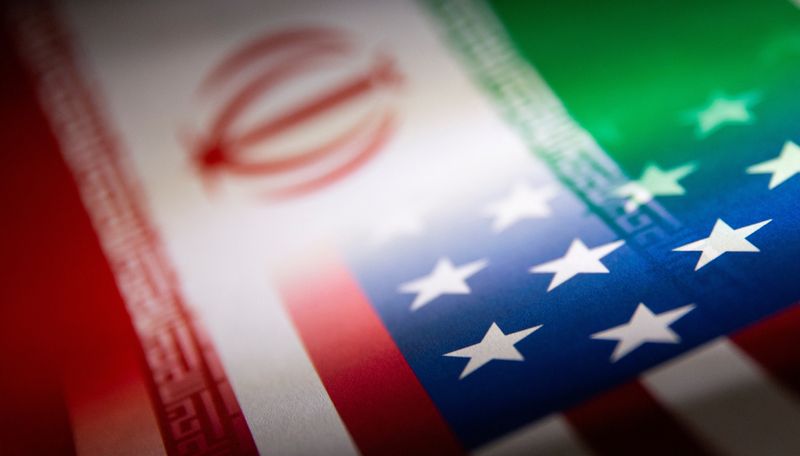Analysis: U.S. and Iran finesse issue of IAEA’s nuclear probes, for now
2022.08.29 07:17

FILE PHOTO: Iran’s and U.S.’ flags are seen printed on paper in this illustration taken January 27, 2022. REUTERS/Dado Ruvic/Illustration/File Photo
By Arshad Mohammed
WASHINGTON (Reuters) – The United States and Iran have found a way to address the U.N. nuclear watchdog’s investigations of Tehran’s atomic program that allows both to claim victory for now but delays a final resolution, according to three sources familiar with the matter.
Tehran has pushed Washington to commit to close probes by the International Atomic Energy Agency (IAEA) into uranium traces found at three undeclared sites before it will fully implement a proposed deal to revive the 2015 Iran nuclear pact.
The United States and its partners, however, reject that stance, arguing the investigations can only conclude when Iran has given satisfactory answers to the Vienna-based agency.
As a result, Iran has said it will not carry out the deal unless the probes have been closed, postponing the fundamental question of whether the IAEA will close them and whether Iran might go ahead with the wider deal if not, the sources said.
Resolution of the so-called “safeguards” investigations is critical to the U.N. agency, which seeks to ensure parties to the Nuclear Non-Proliferation Treaty are not secretly diverting nuclear material which they could use to make a weapon.
While a senior U.S. official said last week that Iran had “basically dropped” some of the main obstacles to reviving the 2015 deal, including on the IAEA, the issue seems to have been deferred.
“Iran originally had wanted a commitment that the IAEA would complete the agency’s safeguards investigations by a date certain,” said a U.S. official on condition of anonymity, saying the United States and its partners refused this.
“Iran came back and stated that if the safeguards issues were not resolved by Re-Implementation Day, they would reserve the right not to take the steps to curb their nuclear program slated to occur on that date,” said the U.S. official.
The draft on reviving the 2015 agreement lays out steps culminating in Re-Implementation Day – a nod to the original deal’s Implementation Day, when the last nuclear and sanctions-related measures fell into place, diplomats have said.
This week, Iran stuck to its guns.
“The IAEA probes should be closed before the Re-Implementation Day” if the 2015 deal is revived, Iran’s nuclear chief Mohammad Eslami said on Wednesday.
The U.S. official said that if Tehran had not cooperated with the IAEA by that time, Iranian leaders would face a choice: “either delay or even forgo the expected sanctions relief, or proceed with implementing the deal even as the investigations into the open cases persist.”
PROBES AND POLITICAL PRESSURE
The IAEA issue threatens to prevent a revival of the 2015 pact, abandoned by then-U.S. President Donald Trump in 2018, under which Iran had curbed its nuclear program in return for relief from U.S., EU and U.N. sanctions.
After reneging on the deal, Trump reimposed U.S. sanctions on Iran, leading Tehran to resume previously banned nuclear activities and reviving U.S., European and Israeli fears that Iran may seek an atomic bomb. Iran denies any such ambition.
Iran has sought to use the talks over reviving the 2015 deal to get the IAEA to close the investigations.
The probes mainly relate to apparently old sites dating to before or around 2003, when U.S. intelligence agencies and the IAEA believe Iran halted a coordinated nuclear arms program.
Iran denies ever having such a program, but information including material that Israel says it seized from an Iranian “archive” of past work raises questions about the matter.
Given the Western refusal to commit to closing the probes by a specific date, and Iran’s insistence it won’t fully carry out the deal if they remain active, there appear to be at least four possible outcomes.
Under the first, Iran would satisfy the IAEA’s concerns in a timely manner and the 2015 deal is resurrected.
Under the second, Tehran would fail to satisfy the IAEA, would refuse to take the nuclear steps to consummate the deal, and Washington would refuse to provide sanctions relief envisaged in the proposed deal’s final phase.
However, nuclear limitations, and sanctions relief, to be provided in earlier phases of the proposed deal would happen.
“As I understand it, the Iranians will freeze high grade enrichment, 20%, 60%, the U.S. will ease some sanctions, a very few, not highly significant,” said a source familiar with the matter.
There is, however, the possibility the nuclear agreement’s timelines could be extended, giving Iran more time to satisfy the IAEA if it chose and delaying the deal’s completion, a U.S. and an Iranian official said.
The U.S. official said there is a provision in the draft text, unrelated to the IAEA issue, that lets Iran or the United States request a delay to Re-implementation Day.
Under a third scenario, Tehran might carry out the deal even if the IAEA probes stay open, a policy reversal that could be difficult for Iranian leaders to swallow or sell at home.
A fourth possibility might be that political pressure could force the IAEA to close the probes even it is not satisfied with Iran’s answers, though U.S. officials say they will not strong-arm the agency.
Eurasia Group analyst Henry Rome said that if a deal were agreed it was more likely than not to be implemented.
“But there would be a lot more uncertainty now than there was back in 2015,” he said.








